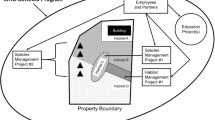Abstract
Corporations own approximately 25% of all private land in the United States and, therefore, play an essential role in protecting biodiversity and maintaining natural habitats. The Wildlife Habitat Council (WHC) is a unique joint venture between conservation organizations and corporations to utilize corporate lands for ensuring biodiversity. The following case studies demonstrate how corporations have helped ensure healthy ecosystems and provided critical leadership in regional efforts. Amoco Chemical Company's Cooper River Plant has been instrumental in developing a cooperative project that involves numerous corporations, plantation owners, private citizens, nonprofit organizations, government agencies, and community groups to develop a comprehensive, ecosystem-based management plan for part of the Cooper River in Charleston, South Carolina, USA. The second case focuses on the Morie Company, a national sand quarry operator headquartered in southern New Jersey, USA. Morie Company is working with WHC, community groups, the Pinelands Commission, and other state regulatory agencies to explore sustainable development opportunities for companies within the Pinelands regulations. The third case takes us to DuPont Company's Asturias, Spain, site. A win—win success story of improved habitat and cost savings is the result of DuPont's concern for the environment, ability to work with a variety of groups, and willingness to consider innovative restoration techniques. The fourth case discusses Consumers Power Company's Campbell Plant in West Olive, Michigan, USA. In addition to implementing projects that contribute to biodiversity, Consumers Power has developed an environmental education field station to teach others about the importance of natural habitats. The final case highlights Baltimore Gas & Electric Company's efforts to maintain habitat for endangered species at their Calvert Cliffs site in Maryland.
Similar content being viewed by others
Literature Cited
Huffman, H., and D. J. Lober. 1995. Stakeholder benefits of a new conservation tool: Corporate wildlife habitat enhancement programs. Duke University, Durham, North Carolina, 31 pp.
Kaplan, R., L. V. Bardwell, H. A. Ford, and S. Kaplan. 1993. Wildlife and nature at work: Report on two sites. Wildlife Habitat Council, Silver Spring, Maryland, 15 pp.
US Department of the Interior. 1995. Cover—May/June Endangered Species Bulletin, Volume 20, No. 3. Washington, DC, 24 pp.
Wildlife Habitat Council. 1992. The economic benefits of wildlife habitat enhancement on corporate lands. Silver Spring, Maryland, 61 pp.
Author information
Authors and Affiliations
Rights and permissions
About this article
Cite this article
Kelly, J.M., Hodge, M.R. The role of corporations in ensuring biodiversity. Environmental Management 20, 947–954 (1996). https://doi.org/10.1007/BF01205976
Issue Date:
DOI: https://doi.org/10.1007/BF01205976




